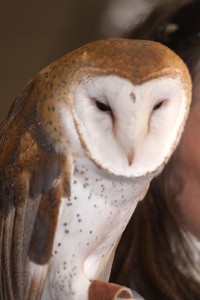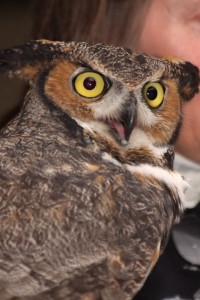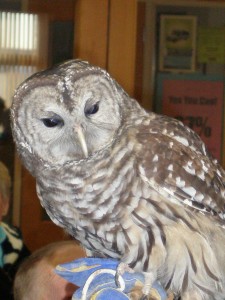Give A Hoot About Monroe County’s Owl Population
Owls are mysterious night prowlers, usually heard but seldom seen. Four species of owls are year round residents in this region: barred owl, great horned owl, eastern screech owl and barn owl. January through March each year they are very vocal and territorial as they begin their annual courtship and mating rituals for nesting. So now is the most common time of the year to hear the loud and boisterous “Who cooks for you! Who cooks for you all!” call of the barred owl, the mellow, yet deep and resonant “hoot, hoot, hoot,” of the great horned owl, or the petite screech owls’ quavering whistles and trills at dusk and throughout the night in the woodlands, farm field edges and wooded residential areas of towns and country subdivisions throughout Southwestern Illinois.
Our resident owl species are “perch hunters,” meaning that they sit on a tree branch or other structure and watch and wait until they see or hear a rodent or other prey on the ground to swoop down upon and attack. Our largest resident species is the great horned owl, which can weigh up to four pounds and have a four-foot wingspan.
Barn Owls are a state-threatened species in Illinois due to population declines as a result of habitat loss. They often have been regarded as a friend to farmers for these owls are highly adaptable to human presence and capture and kill mice and voles that consume stored grain. Barn owls, beige colored birds with white heart-shaped faces, emit characteristic raspy screeches and are classified as state threatened. They hunt for rodents over farm and grasslands and around old farm buildings. They prefer to nest in old farm buildings and are welcome residents on many farms because of their effective rodent control abilities.
During the winter months this region also gets occasional, temporary visits from short- eared owls, long-eared owls, northern saw-whet owls, and snowy owls that migrate from the north in search of food. All owls are carnivorous, predatory birds. Most, but not all species, are specialized to hunt at night for rodents and other small mammals, birds, reptiles, amphibians and insects. There are approximately 205 different owl species worldwide, of which 19 are present in North America. Owls have been in existence for approximately 58 million years according to fossil records.
Owls possess several specialized physiological features that make them excellent night hunters. Four of these features are very critical to their survival and success.
Owls have excellent night vision. Their large, fixed eyes are forward facing and give them binocular vision to absorb minimal light and perceive depth and distance with great precision. Owls cannot move their eyes so they rotate their heads up to 270 degrees to focus on prey.
Owls have excellent hearing. They have asymmetrical ears meaning they are crooked on the sides of their heads – one is further forward and one is higher than the other. This helps them determine direction and distance of prey sounds when they cannot see them. The flat facial disc so characteristic of owl faces helps funnel sound to the birds’ ears and magnifies it as much as ten times to help the birds hear noises humans cannot detect. Several species of owls, such as the great-horned and screech owl, have “ear” tufts on their heads, but these are not ears at all. These tufts help keep the bird camouflaged and are raised or flattened to express moods of interest (upright) or aggression (flattened).
Owls have large hooked beaks and four large talons on each foot. These are critical to capturing, killing and eating prey. Feathers often conceal the true size of their sharp bill, which is adapted for tearing meat. They prefer to swallow their prey whole if it is small enough. Owl feet and talons have two toes pointing forward and two toes backward. This gives the birds a stronger, more powerful grip for capturing and killing prey. Owls eat their entire prey and after digesting it, they will regurgitate hard pellets of indigestible compressed bones, fur, teeth, and feathers.
Owls are light-weight, silent and agile flyers. Their wings are broad and large compared to their body size to improve lift and agility when flying. The serrated, velvety soft, thick, fringe on the leading edge of their primary wing feathers reduces the sound of their flight and aids in stealthy surprise for capture of prey. Their earth-toned feather coloration is ideal camouflage for blending into their natural habitats, another adaptation for sudden surprise and successful hunting.
Owls have been the subjects of cultural folklore and legends, perhaps due to the birds’ large-eyed stately appearance and nocturnal lifestyle. They have often been associated with superstitions surrounding death and wisdom. As predators, they also have been the subject of chagrin and viewed as bad luck or as exterminators of small wild game and domestic livestock, even varmints that should be killed at every opportunity. These beliefs, along with habitat loss, rodent poisons and vehicle collisions in today’s world, have taken tolls on owl populations.
Owls play important roles in ecosystems. They are very important for the control of rapidly reproducing small animals such as mice, rats, and voles and thus maintaining healthy balances in the web of life. Owls are a positive force fulfilling a valuable role on our planet and should be protected and sustained.
CLIFFTOP, a local nonprofit organization, is focused on preserving and protecting area blufflands.
A version of this article appeared in the January 5, 2018, issue of the Monroe County Independent.
© 2018 all content rights reserved Clifftop NFP
Comments are currently closed.



